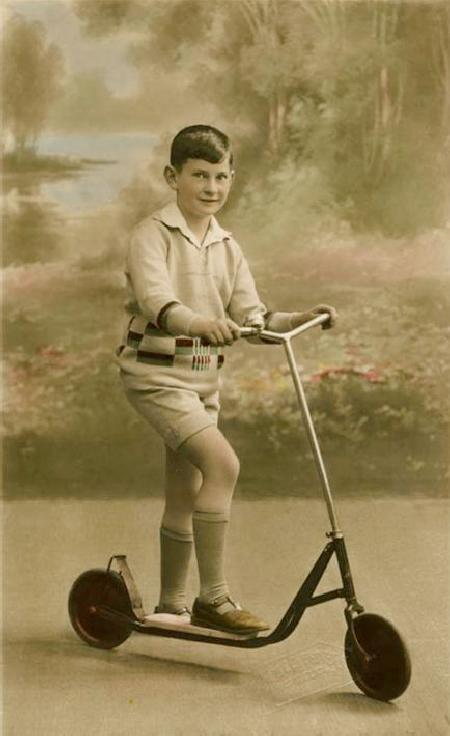
Color Photograph Portrait Tinting: Chronology

Figure 1.--This is a beautifully hand tinted portrait of a boy on a scooter. The studio printed it on silver-geatin RPPC paper and then had it tinted. We are not sure where it was taken, but think it may have been England. It looks to have been taken in the 1930s, but we are not positive.
|
|
We note attempts to colorize black-and-white images from the earliest eforts at photography. Many Daguerreotypes were tinted. A few were colorized in great detail Much more common wee dags with minor color touches like redened cheeks and gilded gold jewelry (1840s). I am not entirely sure why colorizing dags were more common than other portrait types. We suspect that the cost of dags was such that tinting them was only a modest additional cost that the well-heeled clients could easily afford. We also see ambrotypes with rosy cheecks, but not elaborate tinting like some dags (1850s. Nor do we note much effort to colorize tintypes beyound redened cheeks. Albumen paper and CDVs appeared in France (1850s). They became the dominant portrait types (1860s). We notice some beautifully colorized CDVs. This varied widely. Some tinted CDVs seem to have only a slash of one shade dabbed on. Others were beatifully colorized in multiple colors and in great detail. It was, however, not very common to do so. This was even more true for caninent cards shich appeaed in 1886. Studios could semd portraits with color instructions off to studios which specialized in this work. Nitrate-gellarin paper appeared at the turn of the 20th century. At the same time the Brownie and other convenient cameras and improved films caused an explosion of amateur snapshots. These were rarely colorized. Studio portraits could be colorized for an additional fee. This was popular, but because of the fee, only a small portion of the studio portraits were colorized. Some of the work is very good, but it was very difficult to get the skin tones just right, in pat because the studio was working ih a black and white image.and the grey tones interfered with the tinting. Colorization was done into the 1940s and early 50s when color photography became more commercilly available.
The 19th Century
We note attempts to colorize black-and-white images from the earliest eforts at photography. Many Daguerreotypes were tinted. A few were colorized in great detail.
A good example is an unidentified Baltimore family in the 1850s.
Much more common wee dags with minor color touches like redened cheeks and gilded gold jewelry (1840s). I am not entirely sure why colorizing dags was more common than other portrait types. We suspect that the cost of dags was such that tinting them was only a modest additional cost that the well-heeled clients could easily afford.
We also see ambrotypes with rosy cheecks, but not elaborate tinting like some dags (1850s. Nor do we note much effort to colorize tintypes beyound redened cheeks. Albumen paper and CDVs appeared in France (1850s). They became the dominant portrait types (1860s). We notice some beautifully colorized CDVs. This varied widely. Some tinted CDVs seem to have only a slash of one shade dabbed on. Others were beatifully colorized in multiple colors and in great detail. It was, however, not very common to do so. This was even more true for caninent cards shich appeaed in 1886. Studios could semd portraits with color instructions off to studios which specialized in this work.
The 20th Century
Nitrate-gellarin paper appeared at the turn of the 20th century. At the same time the Brownie and other convenient cameras and improved films caused an explosion of amateur snapshots. These were rarely colorized. Studio portraits could be colorized for an additional fee. This was popular, but because of the fee, only a small portion of the studio portraits were colorized. Some of the work is very good, but it was very difficult to get the skin tones just right, in pat because the studio was working ih a black and white image.and the grey tones interfered with the tinting. Colorization was done into the 1940s and early 50s when color photography became more commercilly available. A good example is an unidentified American boy about 1930.
HBC

Navigate the Boys' Historical Clothing Web Site:
[Return to:Main photograph tinting page]
[Return to:Main photography page]
[Introduction]
[Activities]
[Biographies]
[Chronology]
[Clothing styles]
[Countries]
[Girls]
[Bibliographies]
[Contributions]
[Essays]
[FAQs]
[Glossaries]
[Images]
[Links]
[Registration]
[Tools]
[Boys' Clothing Home]
Navigate the Boys' Historical Clothing Web Site:
[Return to the U.S. 19th century shirt chronology]
[Sailor suits]
[Sailor hats]
[Buster Brown suits]
[Eton suits]
[Rompers]
[Shirts and collars]
[Button-on clothing]
[Tunics]
[Smocks]
[Pinafores]
Created: 3:39 AM 1/23/2008
Last updated: 9:24 AM 8/21/2008



